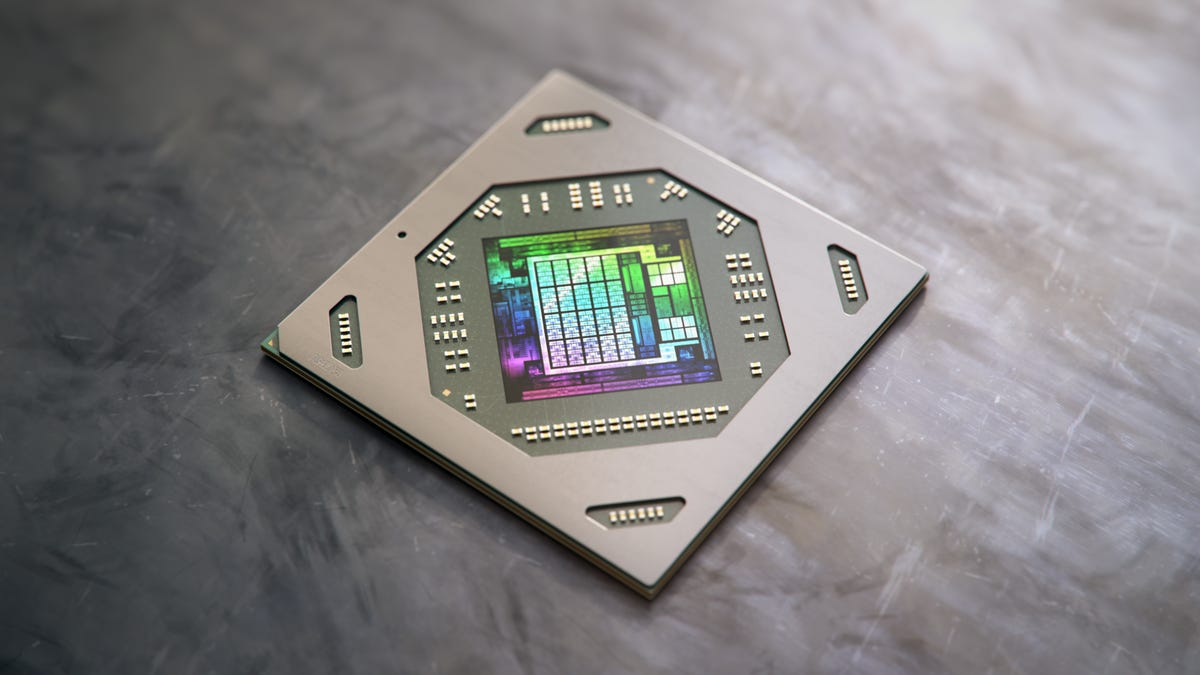AMD Computex keynote brings RX 6800M, the 'AMD Advantage' and more
AMD doubles down on gaming at the virtual version of the annual Computex show.

The AMD Radeon RX 6800M and 6700M GPU
This year's virtual Computex show -- the normally mammoth trade show in Taiwan that's gone virtual for 2021 due to the pandemic -- kicked off with AMD CEO Lisa Su's keynote address, and for once, a keynote made some real news. AMD's long-anticipated mobile GPUs based on its RDNA 2 technology, the Radeon RX 6800M, 6700M and 6600M, debuted during her remarks.
They join AMD's new Advantage Design Framework, a partnership program in the style of Intel Evo and Nvidia Studio for setting standards for premium gaming laptop experiences, as well as the launch of AMD's cross-platform FidelityFX Super Resolution technology for video games.
We've been eagerly awaiting the new GPUs because they bring some of AMD's best new technologies to laptops, notably RDNA 2. That includes Ray Accelerator cores, Infinity Cache on the GPU die, support for Smart Access Memory, which allows AMD's CPU to directly access the GPU memory, and more. The result is lower latency, better performance per watt -- that means better battery life -- and AMD's first step toward hardware-accelerated ray tracing. (AMD's GPUs still effectively lag Nvidia's on DirectX ray tracing, however.)
Radeon RX 6000M mobile GPU specs
| RX 6800M | RX 6700M | RX 6600M | |
|---|---|---|---|
| Compute Units and Ray Accelerators | 40 | 36 | 28 |
| Max power draw (watts) | 145 | 135 | 100 |
| Max GPU frequency | 2.3GHz | 2.3GHz | 2.18GHz |
| Memory | 12GB GDDR6 | 10GB GDDR6 | 8GB GDDR6 |
| Memory interface | 192 bit | 160 bit | 128 bit |
| Infinity Cache | 96MB | 80MB | 32MB |
The new GPUs each have a partner system as the poster child for launch. The RX 6800M arrives this month in the Asus ROG Strix G15 Advantage Edition, which also serves as one of the first systems built within the AMD Advantage Design Framework. HP is slated to debut an Omen 16 equipped with the RX 6600M soon after. Both the RX 6800 and RX 6700 target 1440p gaming, while the RX 6600M goes after 1080p.
A key component in AMD's strategy is the Advantage Design Framework, "the result of a multi-year collaboration between AMD and its global PC partners to deliver the next generation of premium, high performance gaming laptops," the company says. Specifications for Advantage laptops include an AMD Ryzen 5000 series CPU, Radeon RX 6000M series GPU, battery life greater than 10 hours, over 100 frames per second in "today's most visually demanding titles," a display with at least 300 nits brightness and refresh rate at least 144Hz, and cool operation under heavy loads, "all packed into sleek laptop designs." As a poster child, the ROG Strix G15 AE delivers.
The Asus ROG Strix G15 Advantage Edition
AMD also rolled out the Pro (aka business-focused) versions of its Ryzen boxed processors for compact desktops. They're essentially the same as the non-Pro models, which rely on integrated graphics rather than discrete, but with the extra security and manageability features that define the business chips. You'll know them by the last two digits in their names, which are "50" rather than "00."
Another long-awaited release from AMD, we're finally getting the first games with support for its FidelityFX Super Resolution technology this month. FFSR is similar to Nvidia's DLSS AI-driven upscaling technology -- a way to render using smaller textures so you can get higher frame rates with little loss of detail -- but AMD's solution doesn't require proprietary hardware and is open source software. In theory, it should work on Nvidia GTX GPUs as well as Radeon. DLSS not only requires Nvidia hardware, it also requires an RTX-generation GPU. The AMD solution does require that developers build support in their games, though. The first FFSR titles will be announced on June 22.

